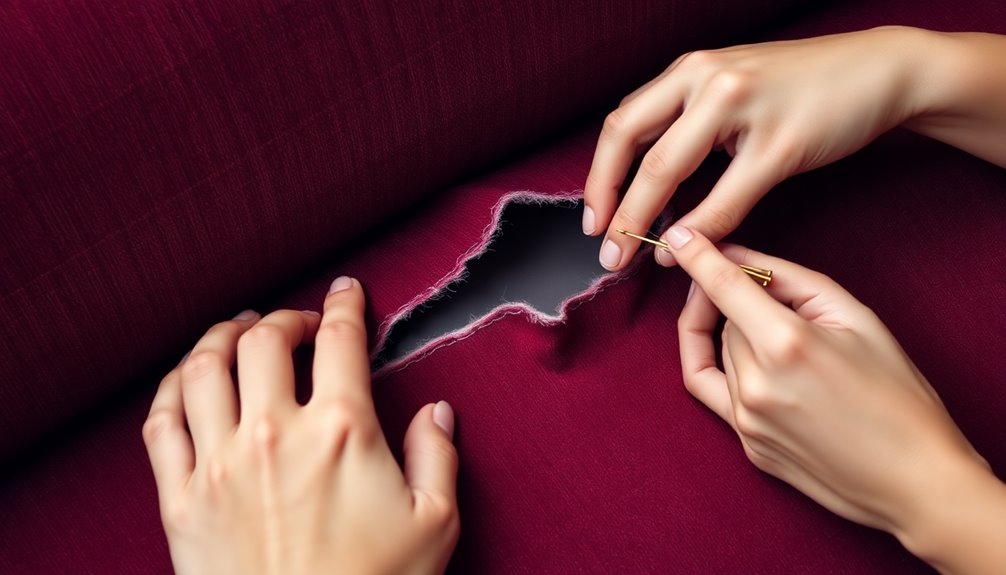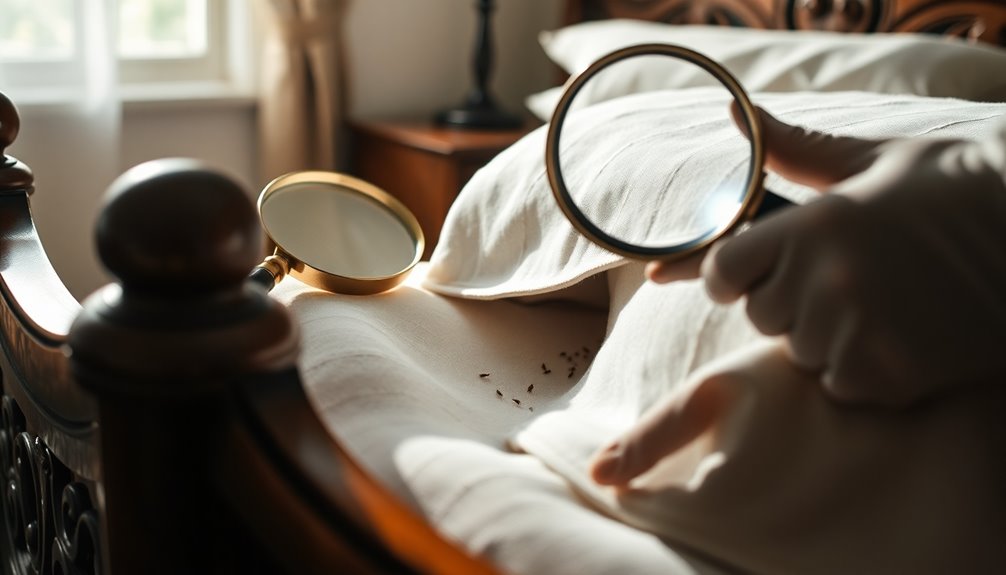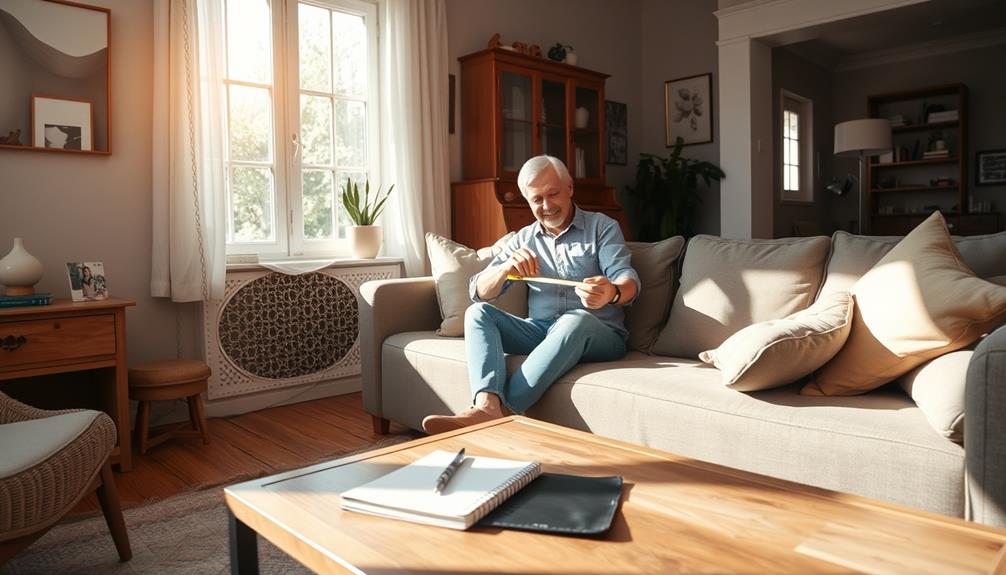To repair torn sofa fabric, start by inspecting the damage. For small tears, use a needle and thread with a whip or slip stitch. If the tear is larger, sew on a patch and secure the edges. Trim any frayed threads to prevent further unraveling, and consider using fabric adhesive for quick fixes. Always match the thread to the fabric for a discreet repair. After fixing, regularly maintain your sofa by vacuuming and applying fabric protector sprays to avoid future damage. There’s plenty more to explore about keeping your sofa looking great and lasting longer. Additionally, for those dealing with fixing torn leather furniture, consider using a specialized leather repair kit that often includes color-matched compounds for seamless results. Applying a leather conditioner after repairs can help restore moisture and flexibility to the material, preventing future cracks and tears. Regular upkeep and protective measures will ensure your sofa remains a stylish and functional centerpiece in your home.
Key Takeaways
- Inspect the torn fabric to assess the damage and determine if it requires simple stitching or a patch for larger tears.
- Gather necessary repair tools, including needle, thread, fabric adhesive, and patches, ensuring the area around the tear is clean.
- Use a whip stitch or slip stitch to sew small tears, and apply fabric adhesive for quick fixes on minor damage.
- For larger tears, sew on a matching patch, securing the edges and reinforcing seams to prevent further damage.
- Test any cleaning or adhesive solutions on an inconspicuous area first to avoid discoloration before proceeding with repairs.
Introduction
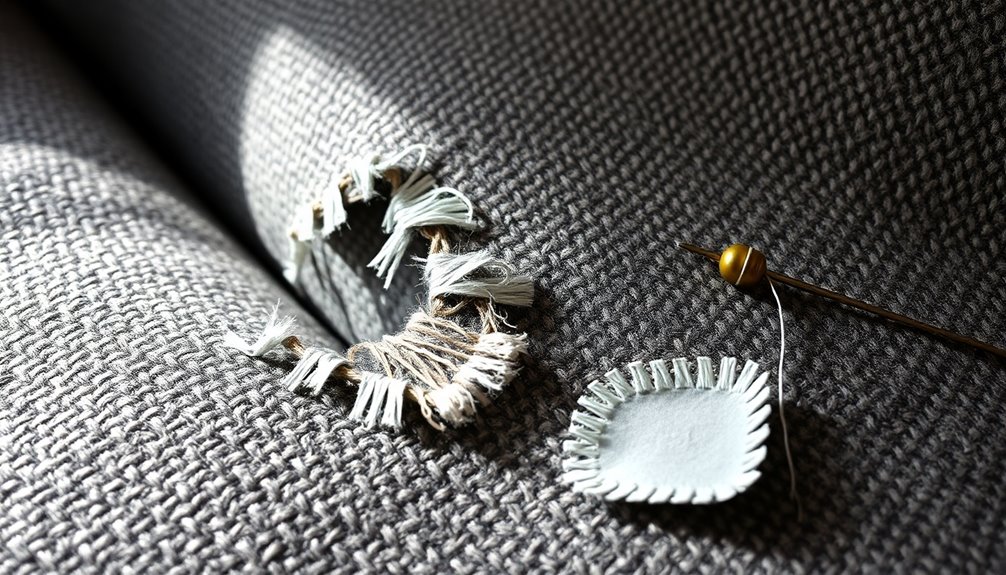
Keeping your sofa in top shape starts with regular upholstery inspections and using fabric-specific cleaning techniques. You'll also want to tackle any stains, like wine, quickly to prevent lasting damage. By being proactive, you can maintain your sofa's appearance and extend its life.
Routine Upholstery Inspections
Regular upholstery inspections are essential for maintaining the longevity and appearance of your sofa. Conduct routine upholstery inspections every few months to catch signs of wear, like frayed edges, loose seams, or minor tears before they turn into larger issues. Focus on high-use areas of the sofa, especially along seams and corners, since these spots are more prone to damage from frequent contact and stress.
When you inspect your sofa, use a flashlight to check darker areas of the upholstery, as hidden damage may not be visible under normal lighting. This thorough approach helps you identify problems early on, ensuring you can address them promptly. Also, remember to assess the fabric type during your inspections; different materials require specific care techniques and can show wear at varying rates.
Keeping a maintenance log can be incredibly helpful. It allows you to track the condition of your upholstery over time, making it easier to spot patterns in damage and schedule timely repairs. By staying proactive with your inspections, you'll keep your sofa looking great and extend its lifespan significantly.
Fabric-Specific Cleaning Techniques
When it comes to cleaning your sofa, knowing the specific fabric type can make all the difference in preserving its look and feel. For cotton upholstery, you can create a gentle cleaning solution using mild soap and water. Apply it with a soft cloth, but be careful not to oversaturate the fabric, as this can lead to mildew.
If your sofa has polyester fabric, regular vacuuming is essential. For spot cleaning, use a specialized upholstery cleaner designed for synthetic materials. This helps maintain the fabric's integrity without causing damage.
For those with leather or vinyl upholstery, it's crucial to use a damp cloth along with a pH-balanced leather cleaner. This will help keep the material supple and prevent any cracking over time.
No matter the fabric, always remember to test any cleaning solution on an inconspicuous area first. This ensures that the color and texture of your fabric remain unchanged. By following these fabric-specific cleaning techniques, you'll not only keep your sofa looking great but also extend its lifespan significantly.
Eliminating Wine Stains Effectively
Wine stains can be a nightmare for your sofa, but acting quickly can make all the difference. Start by blotting the excess liquid with a clean cloth—don't rub it, as that could spread the stain further into the fabric. Once you've blotted up the wine, mix a solution of one part white vinegar, one part water, and a small amount of dish soap. Gently apply this mixture to the stained area using another clean cloth.
After a few minutes, rinse the treated area with cold water and blot it with a dry cloth to absorb any remaining moisture and cleaning solution. If the stain persists, you might want to consider using a commercial upholstery cleaner designed for your specific fabric type. Just make sure to follow the manufacturer's instructions carefully.
Before applying any cleaning solution, it's crucial to test it on an inconspicuous area first. This way, you can ensure it won't damage or discolor your upholstery. By acting fast and using the right techniques, you can effectively eliminate those pesky wine stains and keep your sofa looking its best.
Avoiding Direct Sunlight Damage
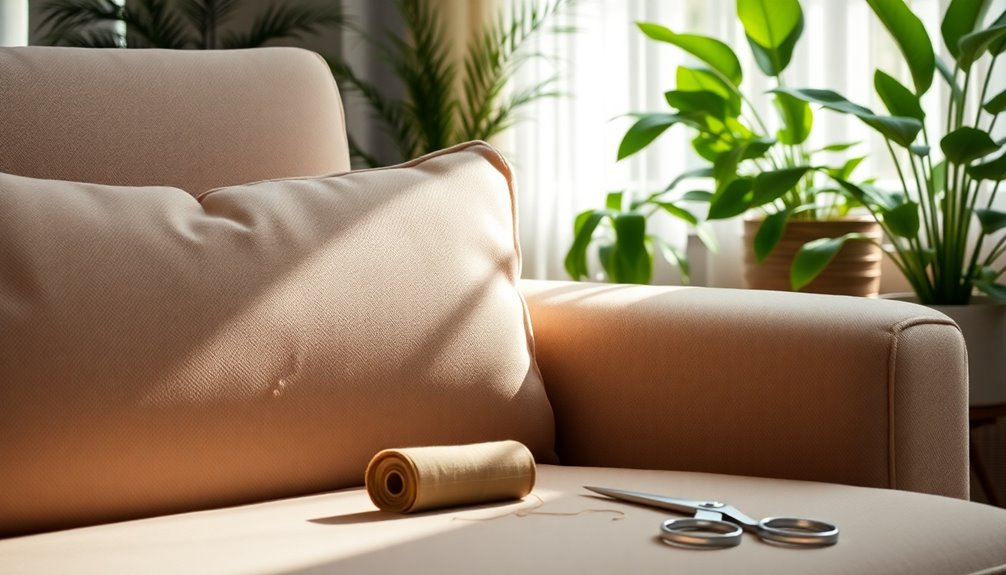
To protect your sofa from the damaging effects of direct sunlight, consider using scratch-resistant fabric options that can withstand wear and tear. Stylish fabric protection solutions not only enhance your decor but also shield your upholstery from harmful UV rays. Regular fabric conditioning treatments can keep your sofa looking fresh while minimizing the risk of fading and deterioration. Additionally, ensuring that your home has proper humidity control can help prevent fabric deterioration and maintain the integrity of your sofa over time.
Scratch-Resistant Fabric Options
Choosing the right scratch-resistant fabric can make a significant difference in the longevity of your sofa, especially in homes with pets or heavy foot traffic. Scratch-resistant fabrics, like microfiber and nylon blends, are engineered to withstand wear and tear, helping to keep your sofa looking great. Fabrics treated with protective finishes, such as Teflon or Scotchgard, not only repel spills and dirt but also provide a barrier against scratches and abrasions.
Additionally, opting for upholstery fabrics with a tight weave, like canvas or denim, can significantly reduce the likelihood of snags and tears, addressing those potential weak spots. Regularly applying fabric protectants can further enhance your upholstery's durability, minimizing damage from scratches and ensuring it remains visually appealing.
While it's crucial to select the right fabric, don't forget to avoid direct sunlight. Using window treatments or strategically placing your furniture away from sunlit areas can help prevent fading and the weakening of the fabric over time. By combining the right fabric choices with protective measures, you'll maintain the integrity of your sofa for years to come.
Stylish Fabric Protection Solutions
Even with the best scratch-resistant fabric options, protecting your sofa from sunlight is vital to maintaining its appearance and longevity. Position your sofa away from direct sunlight to prevent fading and deterioration, especially if you have vibrant colors or delicate materials. To further safeguard your upholstery, consider using sheer curtains or window films. These can effectively diffuse sunlight, reducing harmful UV exposure while still letting in natural light.
Investing in UV-protective fabric sprays adds another layer of defense against sun damage, helping to extend the life of your upholstery. When choosing fabric, look for upholstery materials designed with UV resistance, like solution-dyed acrylics, which are specifically engineered to withstand harsh sunlight.
Additionally, regularly rotating your cushions can help maintain even wear and protect the fabric from prolonged exposure to sunlight. If you want a quick refresh or added protection, slipcovers are a stylish option that can be easily removed and cleaned. And if you find any small tears, don't hesitate to use fabric glue for quick repairs. With these stylish fabric protection solutions, you can keep your sofa looking great for years to come.
Regular Fabric Conditioning Treatments
Maintaining your sofa's fabric through regular conditioning treatments is essential for preserving its elasticity and appearance. Regular fabric conditioning treatments help prevent your upholstery from becoming brittle and prone to tearing over time. By applying a fabric protector spray, you create a barrier against stains and spills, which reduces the likelihood of damage from everyday use.
Direct sunlight can significantly fade and degrade upholstery fibers, so it's crucial to take steps to protect your sofa. Using UV-blocking window treatments can extend the life of your fabric by minimizing sun exposure. Additionally, routine cleaning with appropriate fabric-safe products removes dirt and oils that wear down fibers, ensuring the integrity of your upholstery remains intact.
Consider rotating cushions occasionally and changing the sofa's position to prevent uneven sun exposure and wear on specific areas. This simple practice helps maintain the fabric slightly longer, keeping your sofa looking its best. By combining these actions, you'll not only enhance the longevity of your sofa but also keep it looking fresh and inviting for years to come. So, make regular fabric conditioning treatments a part of your maintenance routine!
Upholstery Stitching Techniques
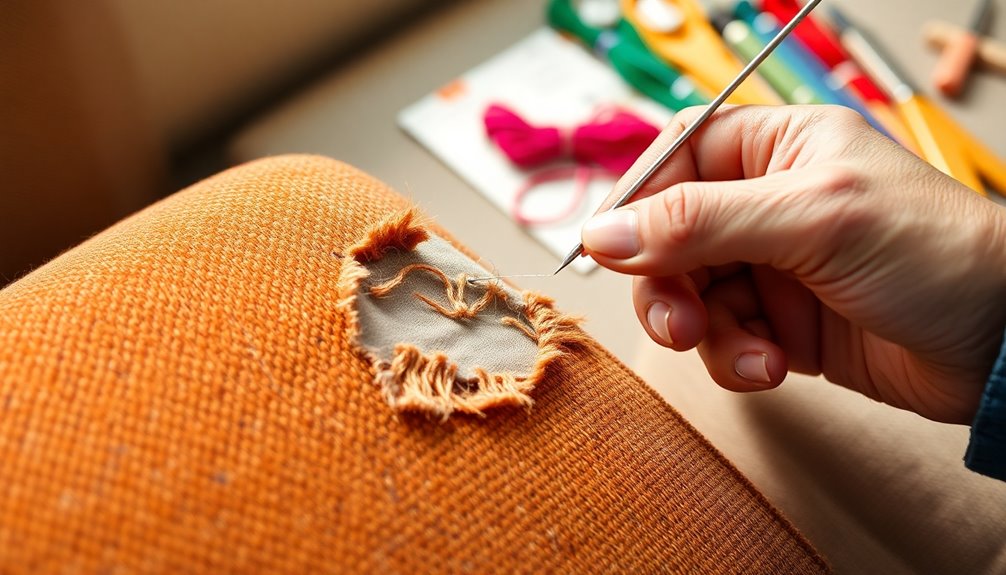
When you're tackling upholstery stitching, it's essential to consider how the overall structure of your sofa affects the repair. Weak frame support can lead to further damage, so ensure the frame is sturdy before stitching. Additionally, leather conditioning treatments and proper cushioning can enhance not just the repair process but also the comfort of your sofa.
Weak Frame Support
A sturdy frame is essential for your sofa's longevity, but weak support can lead to fabric tears and damage. To address this, you'll want to use proper upholstery stitching techniques to reinforce the fabric and maintain its appearance. Start by securing the edges of the tear together, turning them under to prevent fraying. Applying Fray Check will keep the fabric intact as you work.
For the stitching, grab a curved upholstery needle and strong nylon thread. Opt for small, close stitches like the whip stitch or ladder stitch to ensure a neat finish and durability. If your tear is jagged, make sure the thread texture matches the fabric to help conceal the stitches.
When you've finished stitching, knot the thread securely at the end to prevent unraveling. A surgeon's knot is ideal for high-stress areas, providing additional strength. This way, you not only repair the tear but also bolster the frame support, ensuring your sofa stands the test of time. By using these techniques, you can effectively manage weak frame support while preserving the integrity of your sofa's fabric.
Leather Conditioning Treatments
Regularly conditioning leather upholstery is crucial for keeping it supple and preventing tears. Leather conditioning treatments help maintain the longevity of your sofa by restoring moisture and protecting against environmental damage. To start, clean the surface with a gentle leather cleaner to remove any dirt and oils, which can interfere with the conditioner's absorption.
Once the leather is clean, apply a high-quality leather conditioner evenly using a soft cloth. Work the conditioner into the leather in a circular motion to ensure thorough coverage and optimal penetration. This process not only protects the leather but also enhances the appearance of the repaired area.
It's important to test any new conditioner on an inconspicuous spot before applying it fully. This way, you can confirm compatibility and avoid any potential discoloration or adverse reactions. Ideally, you should condition your leather upholstery every 6-12 months to keep it looking its best and to prevent cracks and dryness that can lead to tearing. By following these steps, you'll not only preserve your sofa's beauty but also extend its life significantly. Additionally, maintaining hydration essential for skin health can help keep the leather from becoming too dry and susceptible to damage.
Cushioning for Ultimate Relaxation
Cushioning your sofa for ultimate relaxation can be achieved with effective upholstery stitching techniques that not only repair torn fabric but also maintain its aesthetic appeal. Using a curved upholstery needle makes reaching tight spaces easier, ensuring your needle and thread work remains hidden within the fabric.
Opt for stitching methods like slip stitch, ladder stitch, or whip stitch to securely mend your sofa. When stitching, focus on making tiny stitches close together; this not only creates a neat finish but also helps conceal the stitches, especially in textured fabrics. To prevent any unraveling, always knot the thread securely at the end of your stitching. A surgeon's knot can offer added durability, ensuring your repair lasts.
For a seamless appearance, blend new seams with existing ones by pinching the edges together and maintaining uniform folding throughout the stitching process. This attention to detail will enhance the overall look of your sofa while providing the cushioning you need for relaxation. With these techniques, you'll restore your sofa's beauty and comfort, making it a cozy spot for you to unwind.
Personalized Fabric Choices
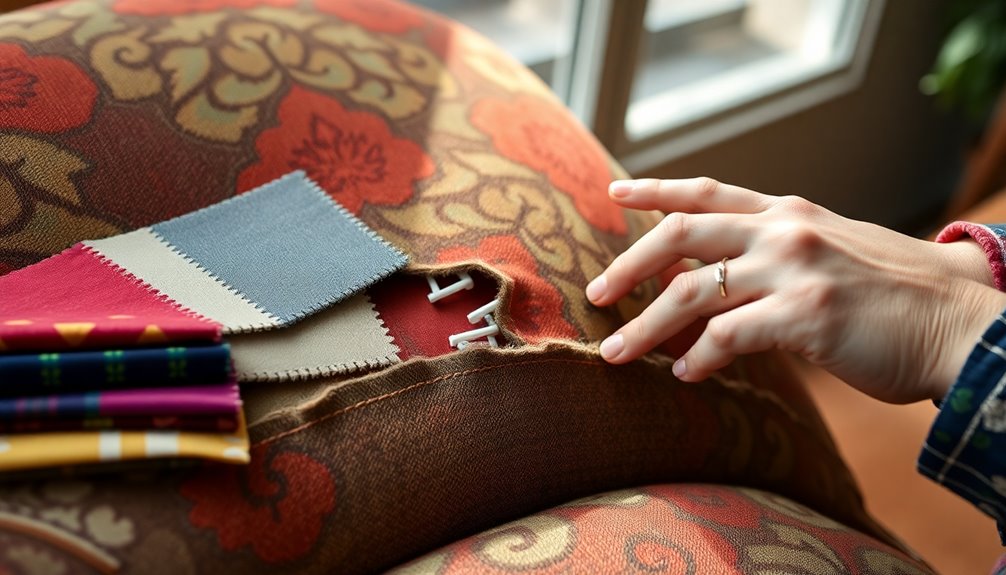
When it comes to choosing fabric for your sofa, understanding your specific needs and preferences can make all the difference. Start by considering durability ratings and ease of cleaning, especially if you have pets or children. Fabrics like microfiber and canvas offer great resistance to stains and wear, making them practical choices for everyday use.
Don't forget to think about patterns and textures. Selecting a fabric with a bit of texture can help conceal minor imperfections and wear over time, giving your sofa a more forgiving appearance. Make sure you test fabric swatches in your intended environment to see how they look with your existing décor and lighting. This way, you'll know if they fit seamlessly into your space.
When it comes to color, think about the overall palette of the room. The right shade can enhance your space's aesthetic appeal, while the wrong one might detract from it. With the right tools and a tiny bit of thought, you'll find the perfect fabric that not only matches your style but also stands up to your lifestyle.
Seasonal Fabric Storage Tips
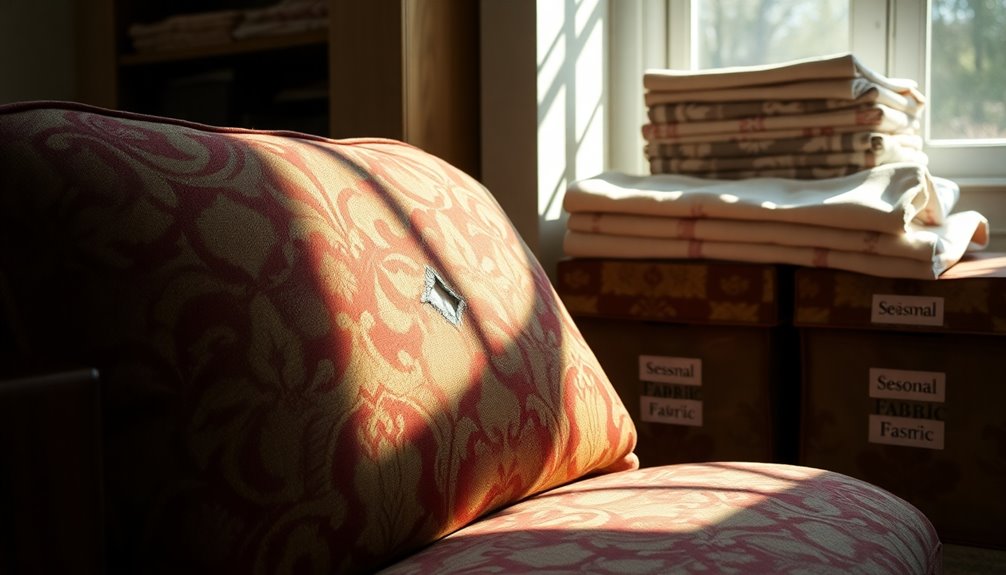
Properly storing your sofa fabric during seasonal changes can extend its life and maintain its appearance. Start by cleaning the fabric thoroughly to remove any dirt, stains, or odors that could set in over time and damage the material. Once it's clean, use breathable fabric storage bags or cotton sheets to protect the sofa from dust and moisture while allowing air circulation. This helps prevent mold and mildew.
Store your sofa in a climate-controlled environment to avoid extreme temperatures and humidity levels that can warp or degrade the fabric. If you can, disassemble removable cushions and store them separately. This minimizes pressure and creasing on the fabric, especially around the edges.
While you might be tempted to stack items on top of the sofa to save space, avoid placing heavy items during storage. This can lead to permanent indentations or damage to the fabric, which you'll want to prevent. By following these storage tips, you'll ensure your sofa fabric remains in great condition and ready for use when the seasons change again.
Conclusion
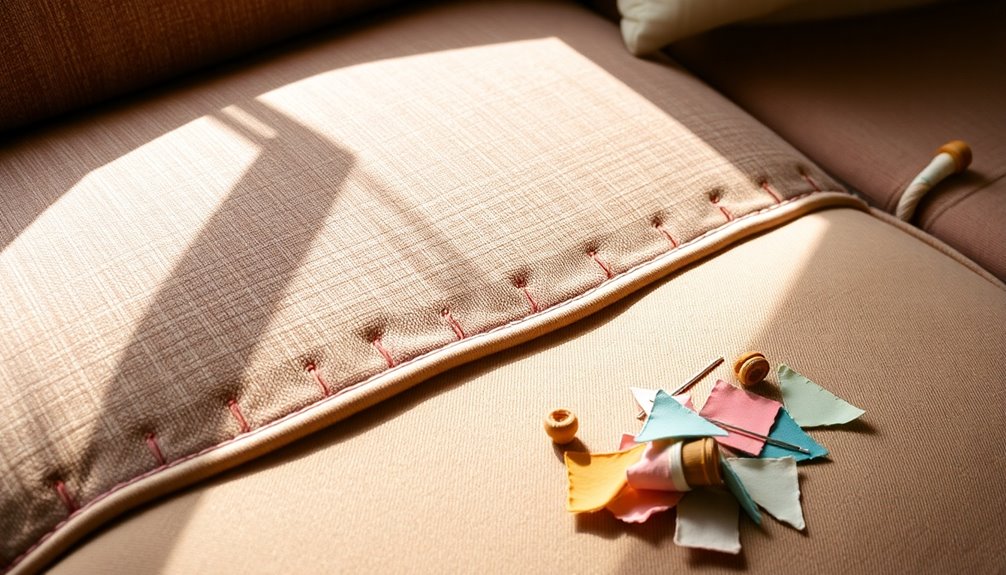
Maintaining your sofa's fabric is important not just during seasonal storage but also when it faces wear and tear. Successfully repairing torn upholstery can significantly extend the life of your furniture while restoring its visual appeal and functionality. By employing effective techniques like patching, sewing, and using fabric glue, you can address various types of damage, including rips and frayed edges.
Before you start, make sure you properly prepare the area by cleaning it and assessing the damage. This step is crucial for achieving a seamless and durable repair. When patching, using matching fabric and employing small, neat stitches will help create an inconspicuous repair that blends well with the existing upholstery. Additionally, keeping your sofa clean and regularly inspecting it for signs of bed bugs can prevent further damage and ensure a comfortable seating experience.
Don't forget that regular maintenance, such as cleaning and protective measures, can help prevent future damage. With a little effort, not only can you repair your sofa, but you can also keep it looking great for years to come. By taking these steps, you ensure your sofa remains a comfortable and stylish centerpiece in your home. Remember, a well-maintained sofa not only enhances your living space but also saves you money in the long run.
Frequently Asked Questions
How Do You Fix Ripped Fabric on a Couch?
To fix ripped fabric on your couch, start by assessing the type of tear—whether it's straight, jagged, or a hole. Treat frayed edges with Fray Check and fold them under neatly. Use a strong nylon thread and a curved needle to stitch the edges together, ensuring a neat appearance. If needed, cut a patch from matching fabric, secure it, and finish by tying off the thread and trimming any excess for a seamless look.
How to Fix a Couch a Dog Chewed?
To fix a couch your dog chewed, first assess the damage by noting the size and location of the chew marks. Cut a patch from durable fabric, slightly larger than the damaged area. Secure it temporarily with a basting stitch before applying a strong adhesive. Use a curved upholstery needle to sew the patch tightly. Finally, clean the couch thoroughly and consider using a protective spray to keep it safe from future mishaps.
Are Couches Worth Repairing?
Yes, couches are definitely worth repairing! If your couch is high-quality and in good shape otherwise, fixing it can save you money compared to buying a new one. Repairs usually cost between $200 and $800, which is much less than the price of a new couch. Plus, a repaired couch can look just as good as new and help the environment by reducing waste. You'll feel satisfied with your choice!
How to Fix a Couch With Non-Removable Cushions?
To fix a couch with non-removable cushions, start by checking for any visible damage. If you spot tears, use a strong fabric adhesive to bond the edges, applying pressure while it dries. For larger tears, cut a patch from similar fabric and glue it over the damaged area. If the fabric's just worn, consider fabric spray paint for a refresh. Regularly vacuum and clean to keep it looking great!
